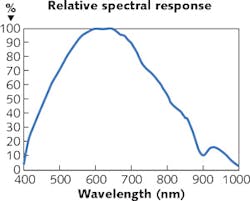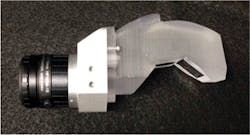By integrating a patented solid-optical-block spectrometer with a high-quantum-efficiency CMOS focal-plane-array (FPA)-based sensor, engineers at Corning Advanced Optics (Keene, NH) have reduced the size, weight, and power (SWaP) requirements for the company's model 410 microHSI selectable hyperspectral airborne remote-sensing kit (SHARK) coherent hyperspectral-imaging (HSI) system. Designed specifically for integration with highly compact unmanned aerial vehicles (UAVs), the 410 SHARK weighs only 1.6 lbs, occupies less than 5.4 × 3.5 × 2.8 in.3, consumes less than 19 W at 12 VDC, and is roughly half the price of comparable HSI systems.
Compactness is achieved in the low-optical-aberration Offner relay spectrometer that integrates a high-efficiency convex diffraction grating (manufactured using a diamond-turning process) into a solid optical block.
Aligned by design and manufacture and without air spacings and discrete optical components, the optical-block configuration significantly reduces optical path length and increases mechanical and thermal robustness, as well as improves transmission throughput for high signal-to-noise ratio and high spatial resolution. The 1936 × 1216 pixel FPA (5.86 μm pixel pitch) of the 410 SHARK yields a 28.6° field of view and 2 nm (maximum) spectral resolution across a 400–1000 nm wavelength range. Reference: R. Holasek et al., Proc. SPIE, 10213, 1021304 (May 22, 2017); doi:10.1117/12.2267856.

Gail Overton | Senior Editor (2004-2020)
Gail has more than 30 years of engineering, marketing, product management, and editorial experience in the photonics and optical communications industry. Before joining the staff at Laser Focus World in 2004, she held many product management and product marketing roles in the fiber-optics industry, most notably at Hughes (El Segundo, CA), GTE Labs (Waltham, MA), Corning (Corning, NY), Photon Kinetics (Beaverton, OR), and Newport Corporation (Irvine, CA). During her marketing career, Gail published articles in WDM Solutions and Sensors magazine and traveled internationally to conduct product and sales training. Gail received her BS degree in physics, with an emphasis in optics, from San Diego State University in San Diego, CA in May 1986.

